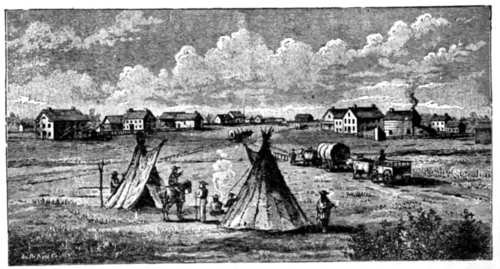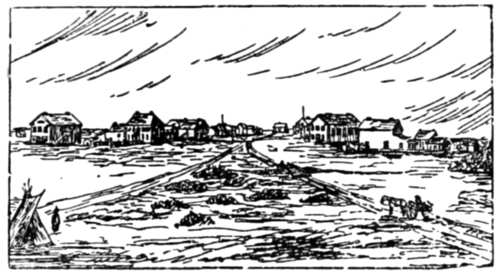|
Canada's military experience, ever
since the excitement of the "Trent Affair," had been in dealing with a
persistent band of Irishmen, posing as Fenians, and egged on by
sympathizers in the United States. Now there was trouble, as we have
seen, in her own borders, and though here again, American influence of a
hostile nature played its part, yet it was those connected with one of
the two races in Canada who were now giving trouble in the Northwestern
prairies. Such an outbreak was more dangerous than Fenianism, for to the
credit of the Irish in Canada, it should be said that they gave no
countenance to the Fenian intruders. The French people in Quebec,
however, had strong sympathies for their race in the Red River
Settlement. No one in Canada believed that any injustice could be done
to either the English or French elements on the banks of Red River, but
Sir George Cartier fought strongly for his own, and was very unwilling
to allow an expedition to go out to Manitoba with hostile intent. Of the
two battalions of volunteers that went out to Red River, one was from
Quebec, but one military authority states that there were not fifty
French-Canadians all told in the Quebec battalion. It had been proposed
that Col. Wolseley, who was to command the Red River Expedition, should
be appointed Governor of the new province of Manitoba, but this was
sturdily opposed by the French-Canadian section of the Cabinet, and Hon.
Adams G. Archibald, a Nova Scotian, was appointed to the post of
Governor. Hampered thus, in so far as exercising any civil functions
were concerned, Col. Garnet Wolseley was chosen by the British officer
in command in Canada—General Lindsay—to organize this expedition.
Wolseley was very popular, having served in Burmah, India, the Crimea
and China. The
Ontario battalion soon had to refuse applications, and from Ontario the
complement of the Quebec battalion was filled up. It was decided also
that a battalion of regulars, with small bodies of artillery and
engineers should take the lead in the expedition. Thus, a force of 1,200
men was speedily gathered together and put at the disposal of Colonel
Wolseley. Two hundred boats, each some 25 to 30 feet long, carrying four
tons as well as fourteen men as a crew, were built; the voyageurs
numbered some four hundred men. No sooner did the Fenians in the United
States hear of this expedition than they threatened Lower Canada, and
spoke of interrupting the troops as they passed Sault Ste. Marie. The
United States also refused to allow soldiers or munitions of war to pass
up their Sault Canal. The rallying began in May, and though the troops
were compelled to debark themselves and their stores at Sault Ste.
Marie, portage them around the Sault and replace them in the steamers
again, yet all the troops were landed at Port Arthur on Lake Superior by
the 21st of June, their officers declaring "our mission is one of peace,
and the sole object of it is to secure Her Majesty's Sovereign
authority." Some time was lost in endeavoring to use land carriage up
from Port Arthur as far as Lake Shebandowan. The difficulties were so
great that the scouts were led to
find another route for the boats up the Kaministiquia River. In this
they were successful; in all this worry from mosquitoes, black flies and
deer flies in millions, the troops preserved their good temper, and Col.
Wolseley said, "I have never been with any body of men in the field so
well fed as this has been." (July 10th.) The real start of the
expedition was from Lake Shebandowan. The three brigades of boats—A. B.
and C.—seventeen in all, got off from Shebandowan shore on the evening
of July 16th; by the 4th of August Rainy River was reached, and at Fort
Frances Colonel Wolseley met Captain Butler, who had acted as
intelligence officer, having adroitly passed under Riel's shadow, and
being able now to give the news required. It was still the statement and
belief of Riel that "Wolseley would never reach Fort Garry." Crossing
Lake of the Woods the regular troops were pushed ahead, and on
descending Winnipeg River they reached Fort Alexander and Lake Winnipeg
on August 20th. Here Commissioner Donald A. Smith, having come through
in a light canoe, met Colonel Wolseley. After a short delay Colonel
Wolseley's command hastened to the Red River, ascended it, and
cautiously approached Fort Garry. It was still uncertain whether Riel
was to oppose the expedition or not. The troops formed for what
emergency might arise, and two small guns were in
readiness should they be required. When Fort Garry was sighted, its guns
were mounted, and everything seemed ready for defence. The officers of
the expedition, as they approached it were quite ready for a shot to be
fired from the battlements, but there was no movement, Riel, Lepine, and
O'Donoghue alone, were left of the Metis levy, and as the 60th Rifles
drew near the Fort the three were seen to escape from the river gate and
to flee across the bridge of boats on the Assiniboine River. Capt.
Huyshe states that the troops took possession of the fort with a
bloodless victory, the Union Jack was hoisted, three cheers were given
for the Queen and the Riel regime was at an end. The militia regiments
arrived on the 27th of August, and two days afterwards the Imperial
troops started back to their headquarters in Ontario. Captain Buller,
who afterward became so celebrated in South Africa, took his company
down the Dawson road to the northwest angle of the Lake of the Woods,
and thus returned eastward, while Colonel McNeil left the country by way
of Red River, through the United States. Shortly afterward, on September
2nd, Lieutenant-Governor Archibald arrived by the Winnipeg River route,
and began his work.

WINNIPEG IN 1871

WINNIPEG IN 1870
The joy of all classes of the people
was unbounded. The English half-breeds had been loyal through the whole
of the disturbances. Kildonan Church
had been the headquarters of the Loyalists in their attempted rally, and
after the execution of Scott, the French half-breeds had gradually
dropped off from Riel, until he and his two companions formed a helpless
trio shorn of all power. |
